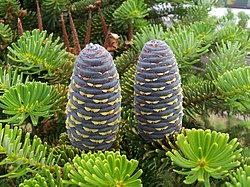| Fir | |
|---|---|
 | |
| Korean fir (Abies koreana) cones and foliage | |
| Scientific classification | |
| Kingdom: | Plantae |
| Clade: | Tracheophytes |
| Clade: | Gymnospermae |
| Division: | Pinophyta |
| Class: | Pinopsida |
| Order: | Pinales |
| Family: | Pinaceae |
| Subfamily: | Abietoideae |
| Genus: | Abies Mill. |
| Type species | |
| Abies alba | |
| Species | |
| Synonyms | |
| |
Firs are evergreen coniferous trees belonging to the genus Abies (Latin: [ˈabieːs] ) in the family Pinaceae. There are approximately 48–65 [2] [3] extant species, found on mountains throughout much of North and Central America, Eurasia, and North Africa. The genus is most closely related to Keteleeria , a small genus confined to eastern Asia. [4]
Contents
- Etymology
- Description
- Leaves
- Cones
- Evolution
- Fossil history
- External phylogeny
- Internal phylogeny
- Taxonomy
- Ecology
- Distribution and habitat
- Pests and diseases
- Uses
- In art
- See also
- References
- Further reading
- External links
They are tall trees that can be distinguished from other members of the pine family by the way in which their needle-like leaves are attached singly to the branches with a circular base, and by their cones, which, like those of cedars, stand upright on the branches like candles and disintegrate at maturity.
The wood of firs is used for pulp to make paper, for plywood, and for indoor construction. Some species serve as Christmas trees, while others are used as decorative trees with their brightly coloured cones. In art, Lucas Cranach the Elder painted Madonna under the fir tree for Wrocław Cathedral in 1510.

































